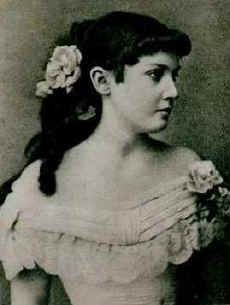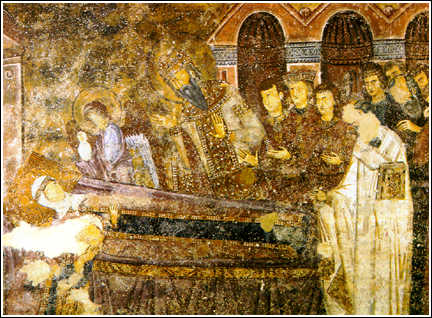|
Draga Mašin
Draginja "Draga" Obrenović ( sr-cyr, Драгиња "Драга" Обреновић; 11 September 1867 – ), formerly Mašin (Машин), was the Queen consort of Serbia as the wife of King Aleksandar Obrenović. She was formerly a lady-in-waiting to Aleksandar's mother, Queen Natalija (until 1897). Early life Draga was the fourth daughter of Panta Lunjevica, a prefect of the Aranđelovac area, and wife Anđelija (''née'' Koljević). Draga was the sixth of seven siblings. She had two brothers, Nikola and Nikodije, and four sisters, Hristina, Đina, Ana and Vojka. Draga's mother was a dipsomaniac and her father died in a lunatic asylum. Draga was the granddaughter of Nikola Lunjevica, a relative of Princess Ljubica of Serbia and close comrade of Prince Miloš, her husband's great-granduncle. Her paternal grandmother was Đurđija Čarapić, a relative of '' vojvoda'' Ilija Čarapić (died 1844), husband of Karađorđe Petrović's daughter Stamenka Karađorđević. ... [...More Info...] [...Related Items...] OR: [Wikipedia] [Google] [Baidu] |
List Of Serbian Consorts
This is a list of consorts of Serbian monarchs during the history of Serbia. Middle Ages Princess- and Grand Princess consorts (–1217) Queen consorts Nemanjić dynasty (1217–1365) Empress consorts Nemanjić dynasty (1346–71) Magnate era Mrnjavčević family (1365–95) Lazarević family (1371–1402) Despotess consorts Lazarević dynasty (1402–27) Branković dynasty (1427–59) Kotromanić dynasty (1459) Despotess consorts (in exile) Branković dynasty (1459–1504) Berislavić dynasty (1504–36) Bakić family (1537) Modern Consort of the Grand Leader Karađorđević dynasty (1804–13) Princess consorts Obrenović dynasty (1815–42) Karađorđević dynasty (1842–58) Obrenović dynasty (1858–82) Queen consorts Obrenović dynasty (1882–1903) Queen consort of Serbs, Croats and Slovenes Karađorđević dynasty (1918–29) Queen consorts of Yugoslavia Karađorđević dynasty (1929–45) See also * List of princesses of Serbia Re ... [...More Info...] [...Related Items...] OR: [Wikipedia] [Google] [Baidu] |
Nikola Lunjevica
Nikola Milićević ( sr-cyr, Никола Милићевић, 1776 – 11 May 1842), known by his demonym as Nikola Lunjevica (Луњевица), was a Serbian Revolutionary and close comrade of Prince Miloš Obrenović I of Serbia. He was born in Lunjevica (hence his nickname), a village in the Sanjak of Smederevo, Ottoman Empire (now Serbia). He was relative of Princess Ljubica of Serbia, father of Serbian politician Panta Lunjevica (1840–1887) and grandfather of Draga, the Queen consort of Serbia (1900–1903). See also *List of Serbian Revolutionaries This is a list of Serbian Revolutionaries, participants in the Serbian Revolution (1804–1817). See also *Serbian revolutionary organizations References Sources * * * * * * {{Serbian revolutionaries * Revolutionaries Revolutionaries ... References Sources * * {{DEFAULTSORT:Lunjevica, Nikola 19th-century Serbian people Serbian revolutionaries People of the First Serbian Uprising People of the Second ... [...More Info...] [...Related Items...] OR: [Wikipedia] [Google] [Baidu] |
King Alexander I Obrenović Of Serbia And Queen Draga, Ca
King is the title given to a male monarch in a variety of contexts. The female equivalent is queen, which title is also given to the consort of a king. *In the context of prehistory, antiquity and contemporary indigenous peoples, the title may refer to tribal kingship. Germanic kingship is cognate with Indo-European traditions of tribal rulership (c.f. Indic ''rājan'', Gothic ''reiks'', and Old Irish ''rí'', etc.). *In the context of classical antiquity, king may translate in Latin as '' rex'' and in Greek as ''archon'' or ''basileus''. *In classical European feudalism, the title of ''king'' as the ruler of a ''kingdom'' is understood to be the highest rank in the feudal order, potentially subject, at least nominally, only to an emperor (harking back to the client kings of the Roman Republic and Roman Empire). *In a modern context, the title may refer to the ruler of one of a number of modern monarchies (either absolute or constitutional). The title of ''king'' is used ... [...More Info...] [...Related Items...] OR: [Wikipedia] [Google] [Baidu] |
Milan I Of Serbia
Milan Obrenović ( sr-cyr, Милан Обреновић, Milan Obrenović; 22 August 1854 – 11 February 1901) reigned as the prince of Serbia from 1868 to 1882 and subsequently as king from 1882 to 1889. Milan I unexpectedly abdicated in favor of his son, Alexander I of Serbia, in 1889. Early years Birth and infancy in exile Milan Obrenović was born in 1854 in Mărășești, Moldavia where his family had lived in exile ever since the 1842 return of the rival House of Karađorđević to the Serbian throne when they managed to depose Milan's cousin Prince Mihailo Obrenović III. Milan was the son of Miloš Obrenović (1829–1861) and his Moldavian wife Marija Obrenović, née Elena Maria Catargiu. Milan's paternal grandfather (Miloš's father) was Jevrem Obrenović (1790–1856), brother of Miloš Obrenović I, Prince of Serbia. Milan was therefore Prince Miloš's grandnephew. He had only one sibling — sister Tomanija. Shortly after Milan's birth, his parents divorc ... [...More Info...] [...Related Items...] OR: [Wikipedia] [Google] [Baidu] |
Civil Engineer
A civil engineer is a person who practices civil engineering – the application of planning, designing, constructing, maintaining, and operating infrastructure while protecting the public and environmental health, as well as improving existing infrastructure that may have been neglected. Civil engineering is one of the oldest engineering disciplines because it deals with constructed environment including planning, designing, and overseeing construction and maintenance of building structures, and facilities, such as roads, railroads, airports, bridges, harbors, channels, dams, irrigation projects, pipelines, power plants, and water and sewage systems. The term "civil engineer" was established by John Smeaton in 1750 to contrast engineers working on civil projects with the military engineers, who worked on armaments and defenses. Over time, various sub-disciplines of civil engineering have become recognized and much of military engineering has been absorbed by civil engineering. ... [...More Info...] [...Related Items...] OR: [Wikipedia] [Google] [Baidu] |
Czech People
The Czechs ( cs, Češi, ; singular Czech, masculine: ''Čech'' , singular feminine: ''Češka'' ), or the Czech people (), are a West Slavic ethnic group and a nation native to the Czech Republic in Central Europe, who share a common ancestry, culture, history, and the Czech language. Ethnic Czechs were called Bohemians in English until the early 20th century, referring to the former name of their country, Bohemia, which in turn was adapted from the late Iron Age tribe of Celtic Boii. During the Migration Period, West Slavic tribes settled in the area, "assimilated the remaining Celtic and Germanic populations", and formed a principality in the 9th century, which was initially part of Great Moravia, in form of Duchy of Bohemia and later Kingdom of Bohemia, the predecessors of the modern republic. The Czech diaspora is found in notable numbers in the United States, Canada, Israel, Austria, Germany, Slovakia, Ukraine, Switzerland, Italy, the United Kingdom, Australia, Fran ... [...More Info...] [...Related Items...] OR: [Wikipedia] [Google] [Baidu] |
Stendhal
Marie-Henri Beyle (; 23 January 1783 – 23 March 1842), better known by his pen name Stendhal (, ; ), was a 19th-century French writer. Best known for the novels ''Le Rouge et le Noir'' ('' The Red and the Black'', 1830) and ''La Chartreuse de Parme'' ('' The Charterhouse of Parma'', 1839), he is highly regarded for the acute analysis of his characters' psychology and considered one of the early and foremost practitioners of realism. A self-proclaimed egotist, he coined the same characteristic in his characters' "Beylism". Life Born in Grenoble, Isère, he was an unhappy child, disliking his "unimaginative" father and mourning his mother, whom he passionately loved, and who died when he was seven. His closest friend was his younger sister, Pauline, with whom he maintained a steady correspondence throughout the first decade of the 19th century. His family was part of the bourgeois class and was attached to the Ancien Regime, explaining his ambiguous view toward Napoleon, t ... [...More Info...] [...Related Items...] OR: [Wikipedia] [Google] [Baidu] |
Karađorđević Dynasty
The Karađorđević dynasty ( sr-Cyrl, Динасија Карађорђевић, Dinasija Karađorđević, Карађорђевићи / Karađorđevići, ) or House of Karađorđević ( sr-Cyrl, Кућа Карађорђевић, Kuća Karađorđević) is the name of the deposed Serbian and former Yugoslav royal family. The family was founded by Karađorđe Petrović (1768–1817), the ''Veliki Vožd'' () of Serbia during the First Serbian uprising of 1804–1813. In the course of the 19th century the relatively short-lived dynasty was supported by the Russian Empire and was opposed to the Austria-Hungary-supported Obrenović dynasty. The two houses subsequently vied for the throne for several generations. Following the assassination of the Obrenović King Alexander I of Serbia in 1903, the Serbian Parliament chose Karađorđe's grandson, Peter I Karađorđević, then living in exile, to occupy the throne of the Kingdom of Serbia. He was duly crowned as King Peter I, a ... [...More Info...] [...Related Items...] OR: [Wikipedia] [Google] [Baidu] |
Karađorđe Petrović
Đorđe Petrović ( sr-Cyrl, Ђорђе Петровић, ), better known by the sobriquet Karađorđe ( sr-Cyrl, Карађорђе, lit=Black George, ; – ), was a Serbian revolutionary who led the struggle for his country's independence from the Ottoman Empire during the First Serbian Uprising of 1804–1813. Born into an impoverished family in the Šumadija region of Ottoman Serbia, Karađorđe distinguished himself during the Austro-Turkish War of 1788–1791 as a member of the Serbian Free Corps, a militia of Habsburg and Ottoman Serbs, armed and trained by the Austrians. Fearing retribution following the Austrians' and Serb rebels' defeat in 1791, he and his family fled to the Austrian Empire, where they lived until 1794, when a general amnesty was declared. Karađorđe subsequently returned to Šumadija and became a livestock merchant. In 1796, the rogue governor of the Sanjak of Vidin, Osman Pazvantoğlu, invaded the Pashalik of Belgrade, and Karađorđe foug ... [...More Info...] [...Related Items...] OR: [Wikipedia] [Google] [Baidu] |
Ilija Čarapić
Ilija Čarapić (, ), was the first Mayor of Belgrade, Serbia. He was born in 1792 in Beli Potok, near Avala, and died in 1844. He was son of the Voyvode Vasa Čarapić and the brother-in-law of Karađorđe, appointed as Voyvode or Duke of Grocka when he was only 18 years old after his uncle, Voyvode Tanasije Čarapić, who died in Prahovo, near Negotin. Vojvoda Ilija Čarapić, with his wife Stamenka Karađorđević had no children. Ilija was the stepfather of Stamenka's daughter Jelena Ristić, who married Đorđe Radojlović, the founder of the Radojlović family. See also * Mayor of Belgrade * |





